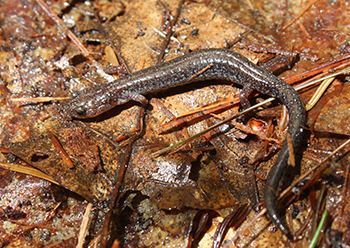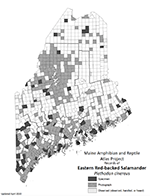Home → Fish & Wildlife → Wildlife → Species Information → Reptiles & Amphibians → Eastern Red-backed Salamander
Eastern Red-backed Salamander
Plethodon cinereus
On this page:

Photo: Trevor Persons
Distinguishing Characteristics

Photo: Trevor Persons
- Small, approximately 2.5 to 5 inches in length
- Three distinct color variations: striped (“red-backed”) morph (abundant); unstriped (“lead-backed”) morph (uncommon to locally common); and erythristic (bright red) morph (rare)
- Red-backed variation: broad reddish, orangish, or reddish-brown stripe along back; dark sides; black or mottled gray underside
- Lead-backed variation: dark gray or black back, dark sides, black or mottled gray underside
Status and Distribution in Maine
- Common and secure
- Statewide
Habitat
- Forests; most abundant in deciduous or mixed forest
- Common under leaf litter, rocks, and decaying logs, and also in burrows
Diet
- Eats invertebrates including ants, beetles, flies, earthworms, and ticks
Seasonal Changes
- Overwinters deep underground in forests
Natural History Notes
- The most abundant amphibian, and likely the most abundant terrestrial vertebrate, in Maine
- Biomass of this species alone is estimated to be higher than the combined biomass of deer and moose in Maine forests
- Mates on land from October through April, eggs are laid the following summer in cavities in decaying wood
Share Your Sighting
There is much still to learn about the distribution and ecology of Maine’s herpetofauna, and we encourage members of the public to share their photo-documented observations as part of the Maine Amphibian & Reptile Atlas Project (MARAP).
To see if a township still needs documentation of a species, consult this distribution map (PDF). If a township lacks a photo or specimen record, we want your observation!
There are two ways to share your observations:
Submit your reptile or amphibian observation online
No service? No problem. Click here to download the survey to your device while connected, then take offline to collect observations from anywhere. Tip: The survey works best on Google Chrome and Safari.
Or upload sightings to the iNaturalist citizen science project through their website at iNaturalist.org or mobile app.
- When submitting an observation through iNaturalist add a description of the location (and other noteworthy information) to the “notes” field. This serves as a check on the locations automatically generated by smartphone cameras, which may be imprecise if cell service or GPS coverage is weak.
Thank you for doing your part to help conserve Maine’s reptiles and amphibians.
